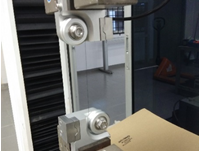EXPERIMENTAL VERIFICATION OF A SNUBBING GRIPPER DESIGN FOR FINE WIRE SPECIMENS IN TENSILE TESTING
Keywords:
shape memory alloy, ultimate tensile stress, gripper, tensile testing, fine wire specimensAbstract
The effects of stress concentration caused by grippers in a simple tensile testing of fine wire specimens might influence the reliable extraction of their mechanical properties. In line with this issue, the effectiveness of a snubbing gripper design for simple tensile test of fine wires was studied. Instron 3366 Universal Testing Machine with 5 kN load cell was used to apply uni-axial tension to two types of fine wire specimens: copper wire with diameter of 0.51 mm and shape memory alloy (SMA) wire, which is nickel-titanium (NiTi) wire with diameter of 0.31 mm. The snubbing gripper was applied to securely grasp the fine wires and the specimens were loaded until they fractured. The corresponding stress versus strain diagram was developed using data obtained from the Instron software to determine the ultimate tensile strength, which was then compared with the theoretical values obtained from the literatures. In general, the findings indicated that no slippage occurred at the fastened part between the gripper and the wire specimen. In addition, there was also longitudinally uniform elongation throughout the wire specimens, which proved there was a uniform stress distribution throughout the wires. Differences of the ultimate tensile strength value for the copper and NiTi wires with those in literatures were found to be 0.15% and 0.59%, respectively. Overall, the good agreement between experimental and theoretical stress versus strain diagrams has verified the proficiency of the snubbing gripper in grasping fine wire specimens for simple tensile tests.
Downloads

Downloads
Published
How to Cite
Issue
Section
License
Copyright (c) 2023 AEROS Journal

This work is licensed under a Creative Commons Attribution-NonCommercial 4.0 International License.

